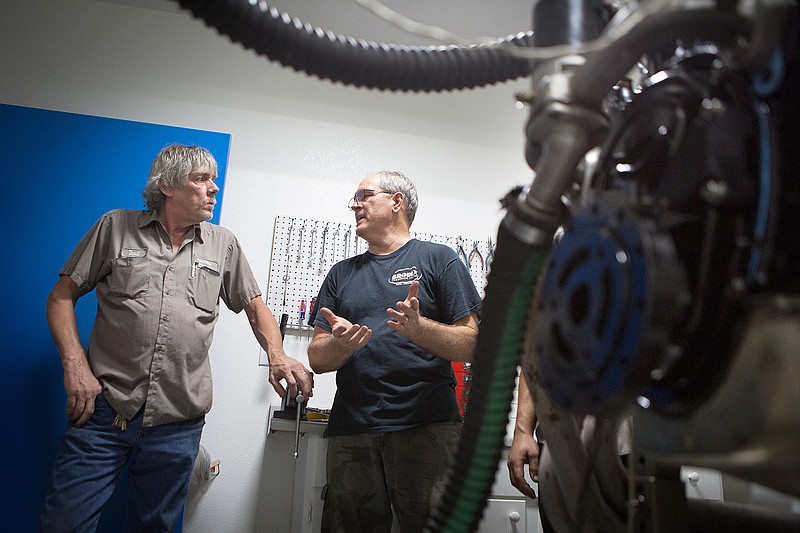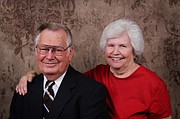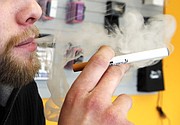Somewhere near Genoa, Ark., a distant rumble can be heard-a sound that means power and speed. It comes from the world of racing autos, a world David Purifoy knows well.
The owner of Purifoy Racing is a specialist in high-performance engines. He uses an engine dynamometer to ensure optimal performance, calibrating and measuring the power an engine produces. It monitors factors such as fuel, air and temperature and their ratios.
The engine dyno, as it's commonly called, holds a running engine and tests it outside the car, giving technicians better access to adjust things such as camshaft, carburetor or fuel-injector timing.
"When working with an engine-repairing it, fine-tuning it-modifying it is easier to do if you can take the engine out of the car. But with modern computerized engines, to get the readings you need to do what you need to do correctly, the engine's computers need to react to things as if the engine is in the car still. That's what the engine dyno does," he said.
With the engine dyno connected to the engine's computer, a technician can test the engine while it's running and see the effects of his modifications and changing environmental conditions.
"Modern car engines are very much computerized, requiring skills and equipment that older cars didn't," David Purifoy said. "You can't just pull anything or attach anything and expect it to work. You have to work with the computers in the components and make sure it is all compatible."
Testing this way also eliminates the driveline power loss seen when using a conventional roller dyno, which tests how much power wheels put to the ground. Having the engine outside the car means more accurate measurements of the engine's performance, since things such as tire wear, wheel weight and drivetrain friction won't affect the outcome.
"Working with modern engines is more complicated," David Purifoy said. "And it is more expensive. So the bar set for entering this field, at least working with modern cars, is higher. This means that there are less younger folks working with cars, which seems to almost contribute to a cultural barrier between older Americans and their cars and younger generations."
David Purifoy, 58, has spent decades working with cars, and besides two years working as a contractor in Iraq, he's practiced his trade in the same shop.
"I earned a fair amount of money there (in Iraq), working on armored limousines and the like," he said. "That was some of the more interesting work."
His love of cars goes back to his childhood. His father, Hobo Purifoy, was a racer who got into modifying his car, a Ford Model A, for better performance. In many ways, the work was easier and more accessible then-without computer components.
"At one point, Hobo and Jerry Basset dropped a 427 Ford engine into that Model A," he said. "That car ran mid-elevens in a quarter-mile in the early (19)70s. She was street legal, too."
Growing up, David Purifoy got more into the technical side of working with cars, spending time with and working for many people who taught him along the way. As he learned, he developed his own ideas about engine work.
"It reached a point I bought my own equipment and tools to pursue my own ideas. This is what would become Purifoy Racing," he said.
The shop owner specializes in high-performance vehicles and built his business around servicing racing cars. He has also brought classic cars back to life. It is an expensive hobby, but one he highly recommends for those who love cars as much as he does.
"If you drive a late-model Mustang or Camaro, for example, they fit you like a glove. The handling can be challenging until you get used to it," he said. "Nothing like pulling up to a red light in a classic car and seeing the looks you get."
But in younger generations, David Purifoy said, he sees a waning of car culture because the hobby is harder to get young people interested in.
"(Modern cars) are more complicated and require a higher level of skill, so it is more difficult to get them into the hobby," he said. "It is harder to get access to the tools or the knowledge to work in the field, to mess with cars."
But for those who love the work, classic cars are a great place to start.
"I love cars, and I do recommend it. For a young person working in this hobby, it has been said, 'Meet a young person who loves cars, there's a young person who doesn't have a drug habit.' They can't afford it."
For those who are thinking of rebuilding a classic car, the shop owner gives a few tips:
- Be realistic about your skills and the help you'll need.
- Gauge your money and how much you want to spend carefully.
- Be flexible with the model of car you want to work with.
- Don't think of it as an investment. Think of it as a hobby.
- Don't take on a rescue project that is out of your league. There's no shame in a project requiring just minor tinkering. It is about learning, but it is also about enjoying your car.
As for turning that hobby into a profession, he said, "Whatever you choose to do in life, make sure it is something you love. That is the secret to never working for a living."



